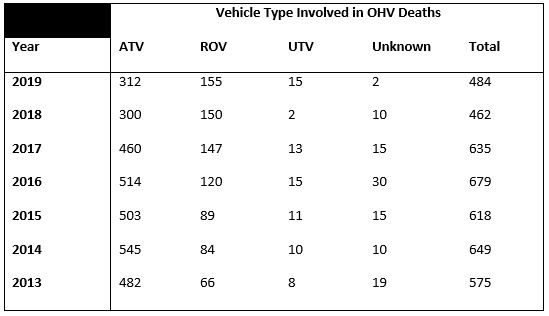Washington, D.C. – Today, Consumer Federation of America (CFA) is releasing its most up-to- date Off-Highway Vehicle (OHV) recall analysis which looks at a decade of data. OHVs include all-terrain vehicles (ATVs), recreational off-highway vehicles (ROVs), and utility task vehicles (UTVs). From January 1, 2010 through February 3, 2020, there were 110 OHV recalls involving 19 different brands.
For every recall issued, the Consumer Product Safety Commission (CPSC) estimates the number of impacted vehicles, the reason for the recall, and the number of deaths and injuries if any.
- Of the 110 recalls analyzed, the CPSC estimates that 1,474,093 vehicles were sold to consumers and subsequently recalled.
- Of the 110 recalls, fire related hazards accounted for the most recalls, 50 recalls (or 45%). Throttle and brake hazards came in second and third with 15 and 11 recalls respectively. Together, these top three hazards represent nearly three-quarters of hazards that led to recalls (69%).
- Injuries and deaths were involved in nearly a quarter of the OHV recalls. Out of the 110 we analyzed, 24 recalls involved at least one injury. Tragically, the most serious involved two deaths: one in 2017, in which the OHV rolled over and did not have seatbelts, resulting in the death of a 14 year old, and another in 2016, in which an OHV caught fire and rolled over resulting in the death of a 15 year old.
CFA also analyzed the brands of the recalled vehicles. Polaris had the most recalls of the 110 we have analyzed, 40 recalls; over triple that of the brand with the second most recalls. Kawasaki and BRP/Can-Am had the second and third highest number of recalls, 12 and 9 respectively. “It is imperative that the CPSC investigate why so many recalls are caused by fire risks and work with manufacturers to prevent these risks before these vehicles enter the market,” stated Rachel Weintraub, legislative director and general counsel with Consumer Federation of America.
In 2019, CFA documented five unilateral recalls that were issued exclusively by the manufacturer, in these cases, Polaris. These “Stop Sale/Stop Ride Notices” were not issued as voluntary corrective actions with the CPSC and the CPSC did not issue a press release to communicate the action to the public. “We are concerned about these unilateral actions and hope that this will not become a trend,” stated Rachel Weintraub. “Enforcement actions should involve the CPSC and should be deemed recalls so that consumers know what they are and find out about them,” Weintraub said.
Fatality Numbers by Year and OHV Type
By tracking news reports and analyzing National Highway Traffic Safety Administration (NHTSA) data, CFA’s OHV Safety Coalition documents OHV deaths. Between January 1, 2013 and February 3, 2020, CFA and its partners have documented over 4,100 deaths involving OHVs (4,102 total). Of these, 720 involved children age 16 or younger (17.55%). Unfortunately, these numbers may continue to rise as we gather more data and as government data is released.
CFA’s OHV Safety Coalition’s analysis of OHV deaths includes detailed breakdowns of fatalities, tracking data such as: vehicle type, fatality location, age of the deceased, gender of the deceased, and whether the fatality occurred on-, or off-road.
- In 2019, CFA identified 484 OHV fatalities. Of these, 312 involved an ATV, 155 involved an ROV, 15 involved UTVs, and two fatalities did not specify vehicle type. CFA is still collecting data for 2019, so these numbers may continue to rise once additional government data is released.
- In 2018, CFA identified 462 OHV fatalities. Of these, 300 involved an ATV, 150 involved an ROV, and two involved UTVs. There were also 10 fatalities that did not identify the vehicle type. These numbers may rise once additional government data is released.
- In 2017, CFA identified 635 OHV fatalities. Of these, 460 involved ATVs, 147 involved ROVs, and 13 involved UTVs. There were 15 fatalities which did not include vehicle type.
- In 2016, CFA identified 679 OHV fatalities, the highest number for any year we have documented. Of these deaths, 514 involved ATVs, 120 involved ROVs, and 15 involved UTVs. There were 30 fatalities for which neither CFA nor government data could identify the vehicle type.

“The data collected by CFA’s OHV Safety Coalition identifies that in 2019, more deaths were caused by ROVs than in any other year,” stated Rachel Weintraub. “The CPSC does not issue annual death and injury data associated with ROVs, but they should. This data is critical to understanding the impact of ROVs on public health and safety.”

